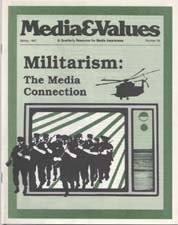GLOBAL: One-Sided Images Feed Cold War Mystique
|
This article originally appeared in Issue# 39
|
The mass media operates today as much on an international level as a national one.
What axe we to do, then, with images of the "enemy" created by Western media and disseminated throughout the world?
As noted throughout this issue, the villains of popular media are often hulking James Bond caricatures. More significantly, however, they represent a larger force of evil that threatens to overwhelm all of Western culture. In addition, the pace of the narrative and selection of images forces us to see the 'enemy" as strange, threatening, uncivilized and power-hungry.
For NATO countries, the enemy is assumed to be the Soviet Union. Thus television news and entertainment often focus on the plight of dissidents, food queues for basic necessities or the humiliation of journalists by the KGB. Very little is said, however, of that country's strengths, like full employment, or housing and other basic necessities made available to the whole population.
In sharp contrast, the West and its allies are consistently portrayed as democratic and civilized, modern and progressive, tolerant of dissent and opposition. We are hardly ever told, in England, for instance, that the BBC regularly censors films and programs, especially those related to Northern Ireland.
We don't hear, either, about the role of the Official Secrets Act in suppressing trade unions and the anti-nuclear and socialist lobbies. Nor is there any mention of the impact of transnational companies on the imbalance of world trade that keeps Third World nations underdeveloped.
These images of us" and "them" is a part of the present Cold War situation. But when these one-sided images are disseminated worldwide by transnational communications systems, developing peoples, too, gradually begin to see themselves and others with the same jaundiced eyes.
A critical reappraisal of cultural values is the only way to counteract such stereotypes of peoples and nations. Media producers must be challenged to provide alternative images as a first step in the propagation of the values of pluralism, coexistence and inter-cultural education. We must lean to trust other peoples and other cultures, and the media must help, not hinder, our fragile efforts.



